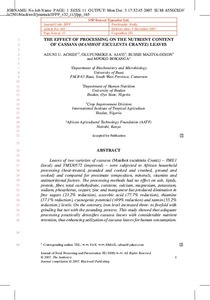| dc.contributor.author | Achidi, A.U. |
| dc.contributor.author | Ajayi, O.A. |
| dc.contributor.author | Maziya-Dixon, B. |
| dc.contributor.author | Bokanga, M. |
| dc.date.accessioned | 2019-12-04T11:15:18Z |
| dc.date.available | 2019-12-04T11:15:18Z |
| dc.date.issued | 2008 |
| dc.identifier.citation | Achidi, A.U., Ajayi, O.A., Maziya‐Dixon, B. & Bokanga, M. (2008). The effect of processing on the nutrient content of cassava (Manihot esculenta Crantz) leaves. Journal of Food Processing and Preservation, 32(3), 486-502. |
| dc.identifier.issn | 0145-8892 |
| dc.identifier.uri | https://hdl.handle.net/20.500.12478/2953 |
| dc.description | First published: 27 May 2008 |
| dc.description.abstract | Leaves of two varieties of cassava (Manihot esculenta Crantz) – TME1 (local) and TMS30572 (improved) – were subjected to African household processing (heat-treated, pounded and cooked and crushed, ground and cooked) and compared for proximate composition, minerals, vitamins and antinutritional factors. The processing methods had no effect on ash, lipids, protein, fiber, total carbohydrate, carotene, calcium, magnesium, potassium, sodium, phosphorus, copper, zinc and manganese but produced diminution in free sugars (23.2% reduction), ascorbic acid (77.7% reduction), thiamine (37.1% reduction), cyanogenic potential (>99% reduction) and tannin (55.2% reduction;) levels. On the contrary, iron level increased three- to fivefold with grinding but not with the pounding process. This study showed that adequate processing practically detoxifies cassava leaves with considerable nutrient retention, thus enhancing utilization of cassava leaves for human consumption. |
| dc.language.iso | en |
| dc.subject | Cassava Leaves |
| dc.subject | Tannins |
| dc.subject | Cyano-Genic Glucosides |
| dc.subject | Antinutritional |
| dc.subject | Grinding |
| dc.subject | Harvest |
| dc.subject | Proximate Composition |
| dc.subject | Vitamins |
| dc.title | The effect of processing on the nutrient content of cassava (Manihot Esculenta Crantz) leaves |
| dc.type | Journal Article |
| dc.description.version | Peer Review |
| cg.contributor.affiliation | University of Buea |
| cg.contributor.affiliation | University of Ibadan |
| cg.contributor.affiliation | International Institute of Tropical Agriculture |
| cg.contributor.affiliation | African Agricultural Technology Foundation |
| cg.coverage.region | Africa |
| cg.coverage.region | Central Africa |
| cg.coverage.region | West Africa |
| cg.coverage.region | East Africa |
| cg.coverage.country | Cameroon |
| cg.coverage.country | Nigeria |
| cg.coverage.country | Kenya |
| cg.isijournal | ISI Journal |
| cg.authorship.types | CGIAR and developing country institute |
| cg.iitasubject | Food Security |
| cg.iitasubject | Nutrition |
| cg.iitasubject | Handling, Transport, Storage And Protection Of Agricultural Products |
| cg.iitasubject | Livelihoods |
| cg.iitasubject | Agribusiness |
| cg.iitasubject | Impact Assessment |
| cg.iitasubject | Farm Management |
| cg.iitasubject | Markets |
| cg.accessibilitystatus | Limited Access |
| local.dspaceid | 94054 |
| cg.identifier.doi | http://dx.doi.org/10.1111/j.1745-4549.2007.00165.x |

